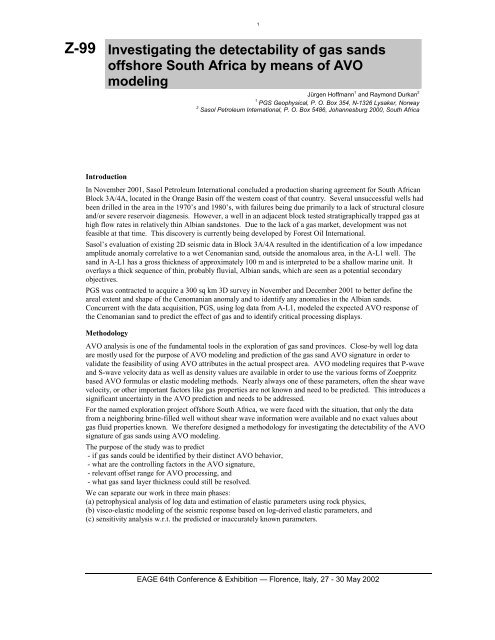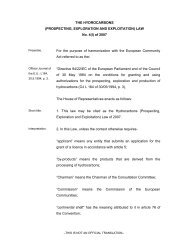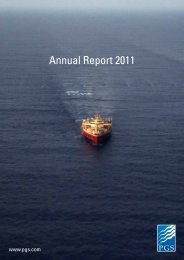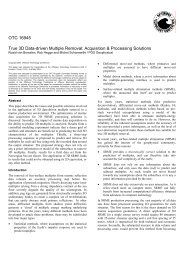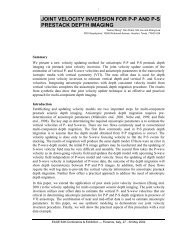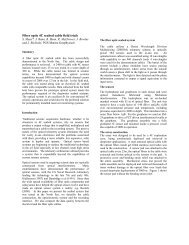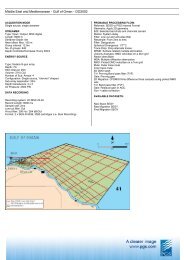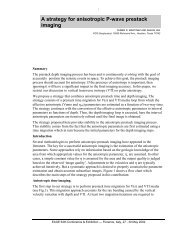Z-99 Investigating the detectability of gas sands offshore ... - PGS
Z-99 Investigating the detectability of gas sands offshore ... - PGS
Z-99 Investigating the detectability of gas sands offshore ... - PGS
You also want an ePaper? Increase the reach of your titles
YUMPU automatically turns print PDFs into web optimized ePapers that Google loves.
1<br />
Z-<strong>99</strong> <strong>Investigating</strong> <strong>the</strong> <strong>detectability</strong> <strong>of</strong> <strong>gas</strong> <strong>sands</strong><br />
<strong>of</strong>fshore South Africa by means <strong>of</strong> AVO<br />
modeling<br />
Jürgen H<strong>of</strong>fmann 1 and Raymond Durkan 2<br />
1 <strong>PGS</strong> Geophysical, P. O. Box 354, N-1326 Lysaker, Norway<br />
2 Sasol Petroleum International, P. O. Box 5486, Johannesburg 2000, South Africa<br />
Introduction<br />
In November 2001, Sasol Petroleum International concluded a production sharing agreement for South African<br />
Block 3A/4A, located in <strong>the</strong> Orange Basin <strong>of</strong>f <strong>the</strong> western coast <strong>of</strong> that country. Several unsuccessful wells had<br />
been drilled in <strong>the</strong> area in <strong>the</strong> 1970’s and 1980’s, with failures being due primarily to a lack <strong>of</strong> structural closure<br />
and/or severe reservoir diagenesis. However, a well in an adjacent block tested stratigraphically trapped <strong>gas</strong> at<br />
high flow rates in relatively thin Albian <strong>sands</strong>tones. Due to <strong>the</strong> lack <strong>of</strong> a <strong>gas</strong> market, development was not<br />
feasible at that time. This discovery is currently being developed by Forest Oil International.<br />
Sasol’s evaluation <strong>of</strong> existing 2D seismic data in Block 3A/4A resulted in <strong>the</strong> identification <strong>of</strong> a low impedance<br />
amplitude anomaly correlative to a wet Cenomanian sand, outside <strong>the</strong> anomalous area, in <strong>the</strong> A-L1 well. The<br />
sand in A-L1 has a gross thickness <strong>of</strong> approximately 100 m and is interpreted to be a shallow marine unit. It<br />
overlays a thick sequence <strong>of</strong> thin, probably fluvial, Albian <strong>sands</strong>, which are seen as a potential secondary<br />
objectives.<br />
<strong>PGS</strong> was contracted to acquire a 300 sq km 3D survey in November and December 2001 to better define <strong>the</strong><br />
areal extent and shape <strong>of</strong> <strong>the</strong> Cenomanian anomaly and to identify any anomalies in <strong>the</strong> Albian <strong>sands</strong>.<br />
Concurrent with <strong>the</strong> data acquisition, <strong>PGS</strong>, using log data from A-L1, modeled <strong>the</strong> expected AVO response <strong>of</strong><br />
<strong>the</strong> Cenomanian sand to predict <strong>the</strong> effect <strong>of</strong> <strong>gas</strong> and to identify critical processing displays.<br />
Methodology<br />
AVO analysis is one <strong>of</strong> <strong>the</strong> fundamental tools in <strong>the</strong> exploration <strong>of</strong> <strong>gas</strong> sand provinces. Close-by well log data<br />
are mostly used for <strong>the</strong> purpose <strong>of</strong> AVO modeling and prediction <strong>of</strong> <strong>the</strong> <strong>gas</strong> sand AVO signature in order to<br />
validate <strong>the</strong> feasibility <strong>of</strong> using AVO attributes in <strong>the</strong> actual prospect area. AVO modeling requires that P-wave<br />
and S-wave velocity data as well as density values are available in order to use <strong>the</strong> various forms <strong>of</strong> Zoeppritz<br />
based AVO formulas or elastic modeling methods. Nearly always one <strong>of</strong> <strong>the</strong>se parameters, <strong>of</strong>ten <strong>the</strong> shear wave<br />
velocity, or o<strong>the</strong>r important factors like <strong>gas</strong> properties are not known and need to be predicted. This introduces a<br />
significant uncertainty in <strong>the</strong> AVO prediction and needs to be addressed.<br />
For <strong>the</strong> named exploration project <strong>of</strong>fshore South Africa, we were faced with <strong>the</strong> situation, that only <strong>the</strong> data<br />
from a neighboring brine-filled well without shear wave information were available and no exact values about<br />
<strong>gas</strong> fluid properties known. We <strong>the</strong>refore designed a methodology for investigating <strong>the</strong> <strong>detectability</strong> <strong>of</strong> <strong>the</strong> AVO<br />
signature <strong>of</strong> <strong>gas</strong> <strong>sands</strong> using AVO modeling.<br />
The purpose <strong>of</strong> <strong>the</strong> study was to predict<br />
- if <strong>gas</strong> <strong>sands</strong> could be identified by <strong>the</strong>ir distinct AVO behavior,<br />
- what are <strong>the</strong> controlling factors in <strong>the</strong> AVO signature,<br />
- relevant <strong>of</strong>fset range for AVO processing, and<br />
- what <strong>gas</strong> sand layer thickness could still be resolved.<br />
We can separate our work in three main phases:<br />
(a) petrophysical analysis <strong>of</strong> log data and estimation <strong>of</strong> elastic parameters using rock physics,<br />
(b) visco-elastic modeling <strong>of</strong> <strong>the</strong> seismic response based on log-derived elastic parameters, and<br />
(c) sensitivity analysis w.r.t. <strong>the</strong> predicted or inaccurately known parameters.<br />
EAGE 64th Conference & Exhibition — Florence, Italy, 27 - 30 May 2002
2<br />
Figure 1 Result from <strong>the</strong><br />
petrophysical log analysis (CPI<br />
computed petrophysical<br />
interpretation). The target <strong>sands</strong><br />
(black arrow) are clearly indicated by<br />
<strong>the</strong> large sand volume (yellow)<br />
between 1650 m to 1750 m and a<br />
porosity <strong>of</strong> about 20 %.<br />
Petrophysical analysis and rock physics<br />
Standard petrophysical well log analysis (Figure 1) was performed on <strong>the</strong> provided data set to calculate porosity<br />
and shale volume. Since no shear wave information was contained, we predicted <strong>the</strong> shear wave using <strong>the</strong><br />
empirical Vp-Vs relations from Castagna et al. (1<strong>99</strong>3) for brine-saturated rocks. We have chosen a simple Vs<br />
prediction, since every Vs prediction may be error prone due to <strong>the</strong> variability <strong>of</strong> Vp-Vs relations and <strong>the</strong> lack <strong>of</strong><br />
reference data for Vs. We ra<strong>the</strong>r decided to address this uncertainty using AVO likelihood analysis.<br />
After log analysis and Vs prediction, <strong>the</strong> required seismic parameters Vp, Vs and density were available,<br />
however, only for <strong>the</strong> case <strong>of</strong> brine filled <strong>sands</strong>. Fluid substitution allows <strong>the</strong> prediction <strong>of</strong> corresponding<br />
parameters for <strong>the</strong> case <strong>of</strong> <strong>gas</strong> filled pores. The o<strong>the</strong>r required parameters were selected based on standard<br />
published data for quartz, brine and <strong>gas</strong>. We applied <strong>the</strong> Gassmann fluid substitution formula (Gassmann, 1951)<br />
to replace <strong>the</strong> brine with <strong>gas</strong> within <strong>the</strong> target <strong>sands</strong> using <strong>the</strong> equations as described in Mavko et al. (1<strong>99</strong>8,<br />
chapter 6.3).<br />
The change in Vp velocity due to fluid substitution is observed in Figure 2. The velocity for <strong>the</strong> <strong>gas</strong> <strong>sands</strong> is<br />
reduced by about 300 m/s compared to that in <strong>the</strong> water <strong>sands</strong>. While many parameters affect <strong>the</strong> result <strong>of</strong> <strong>the</strong><br />
fluid substitution, <strong>the</strong> single most important one is <strong>the</strong> bulk modulus <strong>of</strong> <strong>the</strong> new fluid, i.e. that <strong>of</strong> <strong>the</strong> <strong>gas</strong> (Mavko<br />
and Sengupta, 1<strong>99</strong>9).<br />
Figure 2 Log-plot <strong>of</strong> Vp versus depth for<br />
both cases, i.e. brine filled target <strong>sands</strong><br />
(gray dots) and <strong>gas</strong> filled target <strong>sands</strong><br />
obtained by fluid substitution (colored<br />
dots). The main effect <strong>of</strong> substituting<br />
brine by <strong>gas</strong> in <strong>the</strong> reservoir is a reduction<br />
<strong>of</strong> Vp by about 300 m/s. Vs and density<br />
remain largely unchanged. The color code<br />
shows <strong>the</strong> calculated porosity.
3<br />
Elastic modeling<br />
The seismic response for both data sets was modeled using a visco-elastic reflectivity algorithm. The modeling<br />
included interbed multiples, converted waves, absorption (based on typical quality factor values <strong>of</strong> Qp=200 and<br />
Qs=100). Figure 3 shows a comparison between <strong>the</strong> AVO signature from brine and <strong>gas</strong> filled <strong>sands</strong>, where <strong>the</strong><br />
distinct class 3 AVO response for <strong>the</strong> <strong>gas</strong> <strong>sands</strong> can be observed.<br />
Using <strong>the</strong>se syn<strong>the</strong>tic data and <strong>the</strong> model-based information about <strong>the</strong> incidence angle, we calculated angle range<br />
stacks (Figure 4) to illustrate <strong>the</strong> expected signal after processing. The <strong>gas</strong> sand AVO characteristic is clearly<br />
seen here, also.<br />
Figure 3 Part <strong>of</strong> a syn<strong>the</strong>tic shot ga<strong>the</strong>r for <strong>the</strong> case <strong>of</strong> <strong>gas</strong> filled target <strong>sands</strong> (left) and brine filled <strong>sands</strong> (right).<br />
Geometrical spreading correction and LNMO were applied based on <strong>the</strong> model parameters. The shown <strong>of</strong>fsets<br />
range from 200 m to 2000 m. The top target sand reflection appears at about 1.44 s twt as black event with<br />
increasing amplitude with <strong>of</strong>fset for <strong>the</strong> <strong>gas</strong> case. The seismic data are underlain by <strong>the</strong> incidence angle for<br />
primary reflections at <strong>the</strong> appropriate time and <strong>of</strong>fset.<br />
Figure 4 Angle range stack for <strong>gas</strong> filled target <strong>sands</strong> (left) and brine filled <strong>sands</strong> (right). The three angle<br />
ranges used were 0 – 10 degree, 10 – 30 degree and 30 – 45 degree. The top reflection from <strong>the</strong> target <strong>sands</strong><br />
appears at 1.44 s twt.<br />
Sensitivity analysis<br />
Due to <strong>the</strong> variability <strong>of</strong> <strong>the</strong> target sand properties and <strong>the</strong> uncertainty in <strong>the</strong> shear wave velocity prediction, we<br />
performed a sensitivity analysis. Based on average values for <strong>the</strong> seismic parameters in <strong>the</strong> shale section and for<br />
<strong>the</strong> target <strong>sands</strong>, <strong>the</strong> AVO response <strong>of</strong> a single interface between overlying shale and target <strong>sands</strong> was<br />
investigated for two cases:<br />
Case 1: Shale overlying brine filled <strong>sands</strong> (marked as red crosses)<br />
Case 2: Shale overlying <strong>gas</strong> filled <strong>sands</strong> (marked as blue circles)<br />
For <strong>the</strong> two scenarios we calculated <strong>the</strong> AVO response while taking into account specified uncertainty limits.<br />
The exact AVO response for all cases within <strong>the</strong> specified uncertainty limits was <strong>the</strong>n inverted using a linearised<br />
method to estimate <strong>the</strong> AVO attributes intercept B0 and gradient B1. These AVO attributes were <strong>the</strong>n crossplotted<br />
to analyse <strong>the</strong> ability to separate <strong>the</strong> values from <strong>the</strong> <strong>gas</strong> case and <strong>the</strong> brine case. The sensitivity analysis<br />
was performed for <strong>the</strong> most uncertain or influential parameters, i.e. <strong>the</strong> bulk modulus <strong>of</strong> <strong>the</strong> <strong>gas</strong>, and <strong>the</strong> shear<br />
wave velocity.<br />
EAGE 64th Conference & Exhibition — Florence, Italy, 27 - 30 May 2002
4<br />
Assuming <strong>the</strong> o<strong>the</strong>r seismic parameters are relatively well known, we specified an error range <strong>of</strong> ±100 m/s for<br />
Vp <strong>of</strong> <strong>the</strong> <strong>gas</strong> filled <strong>sands</strong>. This corresponds to a change <strong>of</strong> about 0.8 GPa in fluid bulk modulus, which is<br />
conservative considering typical moduli <strong>of</strong> 2.3 GPa for brine and less than 0.6 GPa or less for <strong>gas</strong>. The AVO<br />
cross plot <strong>of</strong> intercept and gradient for this case (Figure 5 left) shows that even for such a low difference in fluid<br />
compressibility, <strong>the</strong> <strong>gas</strong> and <strong>the</strong> brine case are quite well separated and promise good discrimination.<br />
In <strong>the</strong> second exercise, we assumed all parameters well known except for <strong>the</strong> shear wave velocity for <strong>the</strong> shale<br />
and <strong>the</strong> <strong>sands</strong>. For Vs we specified a conservative uncertainty range <strong>of</strong> ±250 m/s. Repeating <strong>the</strong> cross plot for<br />
this case (Figure 5 right) we can observe that <strong>the</strong> red crosses (brine <strong>sands</strong>) and blue circles (<strong>gas</strong> <strong>sands</strong>) are well<br />
separated. This indicates that <strong>the</strong> AVO response is not very sensitive to <strong>the</strong> shear wave velocity and <strong>the</strong>refore<br />
<strong>the</strong> simplified Vs prediction can be justified in our case.<br />
Figure 5 AVO cross plot <strong>of</strong> intercept B0 vs. gradient B1. Case 1 with brine filled <strong>sands</strong> (red crosses) and case 2<br />
with <strong>gas</strong> filled <strong>sands</strong> (blue circles). Left: Uncertainly in <strong>the</strong> P-wave velocity in <strong>the</strong> <strong>gas</strong> <strong>sands</strong> <strong>of</strong> ∆Vp_<strong>sands</strong> =<br />
±100 m/s. Right: Uncertainly in <strong>the</strong> shear wave velocity <strong>of</strong> ∆Vs = ±250 m/s.<br />
Conclusions<br />
Based on <strong>the</strong> well logs, we conclude that <strong>gas</strong> <strong>sands</strong> in <strong>the</strong> prospect area will exhibit an AVO class 3 behavior,<br />
which can be detected and discriminated from brine <strong>sands</strong> by AVO analysis.<br />
The two main uncertainties in this study are due to <strong>the</strong> prediction <strong>of</strong> <strong>the</strong> shear wave velocity Vs based on <strong>the</strong><br />
petrophysical interpretation <strong>of</strong> <strong>the</strong> lithology, and <strong>the</strong> selected value for <strong>the</strong> bulk modulus <strong>of</strong> <strong>the</strong> <strong>gas</strong>. The<br />
sensitivity analysis showed that <strong>the</strong> latter, i.e. <strong>gas</strong> bulk modulus or Vp for <strong>the</strong> <strong>gas</strong> <strong>sands</strong>, is <strong>the</strong> controlling factor,<br />
while <strong>the</strong> <strong>gas</strong> sand detection via AVO is not very sensitive with respect to <strong>the</strong> shear wave velocity.<br />
An extended analysis addressing <strong>the</strong> <strong>detectability</strong> <strong>of</strong> <strong>gas</strong> <strong>sands</strong> with respect to sand layer thickness showed that a<br />
distinct <strong>gas</strong> sand AVO character can be observed even for layers as thin as 17 m.<br />
References<br />
[1] Castagna, J.P., Batzle, M.L., and Kan, T.K., 1<strong>99</strong>3. Rock Physics – The link between rock properties and<br />
AVO response. In: Offset-dependent Reflectivity, Theory and Practice <strong>of</strong> AVO Analysis, (eds Castagna,<br />
J.P, and Backus, M.), pp 135-171. Society <strong>of</strong> Exploration Geophysicists.<br />
[2] Sengupta, M. and Mavko, G., 1<strong>99</strong>9, Sensitivity analysis <strong>of</strong> seismic fluid detection, 69th Ann. Internat.<br />
Mtg: Soc. <strong>of</strong> Expl. Geophys., 180-183.<br />
[3] Gassmann, F., 1951. Über die Elastizität poröser Medien. Vier. der Natur. Gesellschaft in Zürich, 96, 1-<br />
23.<br />
[4] Mavko, G., Mukerji, T., and Dvorkin, J., 1<strong>99</strong>8. The Rock Physics Handbook. Cambridge University Press.<br />
Acknowledgements<br />
We would like to thank <strong>the</strong> Petroleum Agency South Africa for providing <strong>the</strong> log data <strong>of</strong> well A-L1 and <strong>the</strong><br />
permission to show <strong>the</strong> data.


